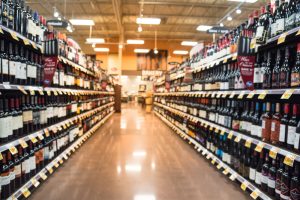
By Alison Douglas, Chief Executive of Alcohol Focus Scotland
Vital Strategies’ NCD advocacy focuses on the four main drivers of NCDs – tobacco, unhealthy diet, physical inactivity and alcohol. Alcohol is responsible for 3.3 million deaths each year across the world.
Alison Douglas, Chief Executive of Alcohol Focus Scotland was an integral part of recent legislation in Scotland that seeks to limit harmful use of alcohol. Minimum pricing is a recommended World Health Organization intervention because it discourages harmful use in people from the very young to those with alcohol dependence. Scotland has some of the most comprehensive alcohol policies in the world.

A minimum unit price establishes a floor below which alcohol cannot be sold. Unlike tax increases it targets cheap, high-strength products favoured by heavier drinkers.
Minimum unit pricing was implemented in Scotland on May 1, 2018, more than eleven years after the policy had first been suggested by health campaigners. This article outlines why and how the policy was developed.
Ten years ago, health professionals became concerned about the increasing harm being caused by alcohol in Scotland. Alcohol related mortality doubled in the previous 15 years and was twice the rate of English and Welsh neighbours[i] whilst liver disease rates increased three-fold over ten years.[ii] These harms were due to increased consumption driven by alcohol being 60% more affordable than it had been in the 1980s. Competition amongst supermarkets, who used alcohol as a means of attracting consumers, pushed prices down and encouraged a shift towards drinking at home.
The shocking impact on health was accompanied by other social harms such as an increase in violent crime and marital breakdown. The total societal cost in 2007 was estimated at £3.6 billion, or £900 for every adult.[iii] It was clear that this was no longer a marginal issue, affecting only a small minority of people. One in three men were estimated to be drinking over the recommended limits and one in four women.[iv] And non-drinkers were also suffering the consequences and footing the bill.
Ministers recognised that something radical needed to be done to turn the tide. They decided that a whole population, evidence-based approach was required given the scale and impact of harmful and hazardous drinking in Scotland.
Health campaigners were clear that the international evidence pointed to increasing price as an essential component of any strategy to tackle the alcohol issue. Taxation had traditionally been seen as the main route to increasing price but this option was not available to Scotland as taxation powers were reserved to the UK Government. In December of 2007, Scottish Health Action on Alcohol Problems (SHAAP) published a report looking at different options to increase price. It recommended that the Scottish Government implement a minimum unit price and a ban on discounting prices.
SHAAP, Alcohol Focus Scotland and other partners helped to build support for minimum price across children’s and development NGOs, and the police, ensuring that both these two proposals were included in a consultation paper issued by the Scottish Government in June 2008 on its new alcohol strategy.
“Changing Scotland’s Relationship with Alcohol: A discussion paper on our strategic approach” stated the government’s commitment to taking a population-wide approach and outlined a “robust package of measures”, including a unit minimum price. A minimum unit price establishes a floor below which alcohol cannot be sold. Unlike tax increases it targets cheap, high-strength products favoured by heavier drinkers and by young people. As it directly affects the price paid by the consumer, these price increases cannot be absorbed by the retailer. The price of a product = price per unit x strength of alcohol (alcohol by volume or ABV) x volume (litres) x 100.[v]
Although minimum pricing was a cornerstone of the strategy the Government made more than forty other commitments.[vi] Most notably they banned multi-buy discounts such as ‘3 for the price of 2’, reduced the drink driving limit to 50mg/100ml blood, and established a program of alcohol early brief interventions.
Key to making the political and legal case for minimum unit pricing was modelling undertaken by the University of Sheffield looking at how different groups of Scottish consumers were likely to respond to price increases. This demonstrated that harmful drinkers would be most affected as they tend to favour cheap, high-strength drinks which minimum pricing targets.
Under a 50 pence per unit minimum price, it was expected consumption would be reduces by seven percent.[vii] Moderate drinkers would be largely unaffected, paying only an extra £2 per year.[viii] The research suggested that 58 lives would be saved in the first year and 1,299 fewer people would be admitted to hospital. And the effects build over time, with 121 lives expected to be saved and 3,200 fewer people admitted to hospital by year 20.[ix] There was also expected to be a reduction in the number of crimes – around 3,500 less per year.
Parts of the alcohol industry – notably spirit and wine producers – put up considerable opposition to minimum unit pricing. They argued that alcohol consumption was a personal choice; that only a small minority drank ‘excessively’; and that minimum price would unfairly punish moderate drinkers. They said that it wouldn’t work and that the Sheffield modelling was unreliable. They also claimed that other countries would respond by discriminating against exports of whisky. Health advocates helped rebut these claims and built political and public support by providing briefings, undertaking research, meeting with decision makers and by keeping the issue in the media. The Scottish Parliament approved the legislation to establish minimum unit pricing unopposed in May 2012.
Having lost the political argument, the Scotch Whisky Association and other trade bodies sought to challenge the legality of minimum pricing. After a series of court cases, over five years, the UK Supreme Court finally and unanimously ruled in the Scottish Government’s favour in November 2017. They confirmed that minimum pricing is appropriately targeted, lawful and proportionate. This paved the way for minimum unit pricing to be implemented in Scotland in May 2018.
The legislation contains what is known as a ‘sunset clause’, which means it will expire after the sixth year of implementation unless the Scottish Parliament actively votes for it to continue. To inform that decision a review report will be presented to parliament on the impact of MUP after five years of operation. An extensive independent evaluation programme has been established by NHS Health Scotland to inform this report, which will consider the impact on alcohol producers and licence holders, as well as on Scotland’s licensing objectives (which include preventing crime and disorder, protecting and improving public health, and protecting children and young people from harm). This will be an invaluable resource for researchers and policy makers everywhere.
Other countries are already actively seeking to implement minimum pricing, including Wales and the Republic of Ireland, as well the Northern Territories in Australia.
What learning can we share? The most important factors in the Scottish success have been: political will and the tenacity to see the policy through; committed and skilled campaigners able to build alliances beyond health; robust international evidence and first-class Scotland-specific modelling.
References
[i] Changing Scotland’s Relationship with Alcohol: A discussion paper on our strategic approach, Scottish Government, June 2008.
[ii] Scottish Government (2008), op cit.
[iii] The York Economics Consortium, York University, 2008, The Societal Cost of Alcohol Misuse in Scotland for 2007.
[iv] Scottish Government (2008), op cit.
[v] For example, under 50p per unit, the minimum price of a 2 litre bottle of 7.5% ABV cider, which contains 15 units or 120 grams of alcohol (more than the Chief Medical Officers’ weekly recommended limit of 14 units), has increased in price from £2.52 to £7.50 (0.50 x 7.5/100 x 2 x 100 = £7.50).
[vi] Changing Scotland’s Relationship with Alcohol: A Framework for Action, Scottish Government, February 2009.
[vii] Angus, C., Holmes, J., Pryce, R., Meier, P. & Brennan, P. (2016). Model-based appraisal of the comparative impact of Minimum Unit Pricing and taxation policies in Scotland An adaptation of the Sheffield Alcohol Policy Model version 3. ScHARR, University of Sheffield
[viii] Angus et al (2016) op cit.
[ix] Angus et al (2016) op cit.